TYM T354 Operator Manual
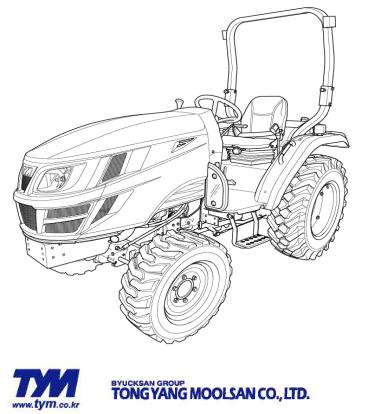
TYM
OPERATOR’S MANUAL
FOR
TRACTORS
T354
DaeYong B/D, 7, Eonju-ro 133-gil, Gangnam-gu, Seoul, Korea ■ TEL: 82-2-3014-2800, FAX:82-2-3014-2852 ■ www.tym.co.kr
YANMAR
WARRANTIES
YANMAR LIMITED WARRANTY
What is Covered by this Warranty?
YANMAR warrants to the original retail purchaser that a new YANMAR TNV common rail series industrial engine will be free from defects in material and/or workmanship for the duration of the warranty period.
Note: YANMAR engines may be equipped with external components including, but not limited to: wiring harnesses, electrical devices, control panels, radiator, air filters, fuel/or exhaust systems that are supplied and/or installed by manufacturers other than YANMAR. For warranty information on such external components, please contact the machine or component manufacturer directly or see your authorized YANMAR dealer or distributor.
This warranty is provided in lieu of all other warranties, express or implied. YANMAR specifically disclaims any implied warranties of merchantability or fitness for a particular purpose, except where such disclaimer
is prohibited by law. If such disclaimer is prohibited by law, then implied warranties shall be limited in duration to the life of the express warranty.
How Long is the Warranty Period?
The YANMAR standard limited warranty period runs for a period of twenty-four (24) months or Two-thousand(2000) engine operation hours, whichever occurs first. An extended limited warranty of thirty-six(36) months or three thousand(3000) engine operating hours, whichever occurs first, is provided for these specific parts only: the cylinder block, cylinder head, crankshaft forging, connecting rods, flywheel, flywheel housing, camshaft, timing gear, and gear case. The warranty period for both the Standard limited warranty and the extended limited warranty (by duration or operation hours) begins on the date of delivery to the original retail purchaser and is valid only until the applicable warranted duration has passed or the operation hours are exceeded, whichever comes first.
1
YANMAR limited warrantycontinued
What the Engine Owner must Do:
If you believe your YANMAR engine has experienced a failure due to a defect in material and/or workmanship, your must contact an authorized YANMAR industrial engine dealer or distributor within Thirty (30) Days of discovering the failure, You must provide proof of ownership of the engine, proof of the date of the engine purchase and delivery, and documentation of the engine operation hours. Acceptable forms of proof of delivery date include, but are not limited to: the original warranty registration of sales r eceipts or other documents maintained in the ordinary course of business by YANMAR dealers and/or dis tributors, indicating the date of delivery of the YANMAR product to the original retail purchaser, This in formation is necessary to establish whether the YANMAR product is still within the warranty period. Thus, YANMAR strongly recommends you register your engine as soon as possible after purchase in order to facilitate any future warranty matters.
You are responsible for the transportation of the engine to and from the repair location as designated by YANMAR.
To Locate an Authorized YANMAR Industrial Engine Dealer or Distributor:
You can locate your nearest authorized YANMAR industrial engine dealer or distributor by visiting the YANMAR Co,. Ltd. Website at:
http://www.yanmar.co.jp (The Japanese language page will be displayed.) For English language “click” on “English Page.”)
●“click” on “Network” in the website heading to vies the “YANMAR Worldwide Network.”
●Choose and “Click” on the desired product group.
●“Click” on the Icon closest to your region.
●“Click” on the desired country or associate company to locate your nearest authorized YANMAR Industrial engine dealer or distributor.
You may also contact YANMAR by clicking on “Inquiry” in the website heading and typing in your Question or comment.
What YANMAR will DO:
YANMAR warrants to the original retail purchaser of a new YANMAR engine that YANMAR will make such repairs and/or replacements at YANMAR’s option, of any part(s) of the YANMAR product covered by this warranty found to be defective in material and/or workmanship. Such repairs and/or replacements will be made at a location designated by YANMAR at no cost to the purchaser for parts or labor.
2
YANMAR limited warrantycontinued
What is no Covered by this Warranty?
This warranty does not cover parts affected by or damaged by ant reason other than defective materials or workmanship, including, bur not limited to, accident, misuse, abuse, “Acts of God,” neglect, improper installation, improper maintenance, improper storage, the use of unsuitable attachments or parts, the use of contaminated fuels, the use of fuels, oils, lubricants, or fluids other than those recommended in your
YANMAR Operation Manual, unauthorized alterations or modifications, ordinary wear and tear, and rust or corrosion. This warranty does not cover the cost of parts and/or labor required to perform normal/scheduled maintenance on your YANMAR engine. This warranty does not cover consumable parts such as, but not limited to, filters, belts, hoses, fuel injector, lubricants and cleaning fluids. This warranty does not cover the cost of shipping the product to or form the warranty repair facility.
Warranty Limitations:
The foregoing is YANMAR’s only obligation to you and your exclusive remedy for breach Of Warranty. Failure to follow the requirements for submitting a claim under this warranty may result in A waiver of all claims for damages and other relief. In no event shall YANMAR or any authorized
Industrial engine dealer or distributor be liable for incidental, special or consequential damages.
Such consequential damages may include, but not be limited to, loss of revenue, loan payments, cost of rental of substitute equipment, insurance coverage, storage, lodging, transportation, fuel mileage, and telephone costs. The limitations in this warranty apply regardless of whether your claims are based on breach of contract, tort(including negligence and strict liability) or any other theory. Any action arising hereunder must be brought within one (1) year after the cause of action accrues or it shall be barred. Some
states and countries do not allow certain limitations on warranties or for breach of warranties. This warranty gives you specific legal rights, and you may also have other rights which vary
Form state to state and country to country. Limitations set forth in this paragraph shall not apply to the
extent that they are prohibited by law.
Warranty Modifications:
Except as modified in writing and signed by the parties, this warranty is and shall remain the complete and exclusive agreement between the parties with respect to warranties, superseding all prior agreements, written and oral, and all other communications between the parties relating to warranties. No person or entity is authorized to give any other warranty or to assume any other obligation on behalf of YANMAR, either orally or in writing.
Questions:
If you have any questions or concerns regarding this warranty, please call or write to the nearest authorized YANMAR industrial engine dealer or distributor or other authorized facility.
3
EMISSION SYSTEM WARRANTY
YANMAR CO., LTD. LIMITED EMISSION CONTROL SYSTEM WARRANTY – USA ONLY
Your Warranty Rights and Obligations:
■ California
The California Air Resources Board (CARB), the Environmental Protection Agency (EPA) and YANMAR Co,. Ltd. hereafter referred to as YANMAR, are pleased to explain the emission control system warranty on your industrial compression-ignition engine. In California, model year 2000 or later off-road compression-ignition engines must be designed, built and equipped to meet the state’s stringent anti-smog standards. In all states, 1998 and later non-road compression-ignition engines must be designed, built and equipped to meet the United States EPA emissions standards. YANMAR warrants the emission control system on your engine for the periods of time listed below provided there has been no abuse, neglect or improper maintenance of your engine.
Your emission control system may include parts such as the fuel injection system, the air induction system, the electronic control system, EGR(Exhaust Gas Recirculation) system and Diesel Particulate Filter. Also included may be hoses, belts, connectors and other emission-related assemblies.
Where a warrantable condition exists, YANMAR will repair your non-rod compression-ignition engine at no charge to you including diagnosis, parts and labor.
Manufacturer’s Warranty Period:
The model year 1998 or later certified and labeled non-road compression-ignition engines are warranted for the periods listed below. If any emission-related part on your engine is found to be defective during the applicable warranty period, the part will be replaced by YANMAR.
If your engine |
And its |
And its |
Then its warranty period is |
is certified as |
maximum |
rated |
|
|
Power is |
speed is |
|
|
|
|
|
Variable speed |
kW<19 |
Any speed |
1,500 hours or two (2) years whichever comes first. |
or |
|
|
In the absence of a device to measure the hours of use, |
Constant speed |
|
|
The engine has a warranty period of two(2) years. |
|
|
|
|
Constant speed |
19 ≤ kW < 37 |
3,000rpm |
1,500 hours or two (2) years whichever comes first. |
|
|
or higher |
In the absence of a device to measure the hours of use, |
|
|
|
The engine has a warranty period of two(2) years/ |
|
|
|
|
Constant speed |
19 ≤ kW <37 |
Less than |
3,00hours of five (5) years whichever comes first. |
|
|
3,000rpm |
In the absence of a device to measure the hours of use, |
|
|
|
the Engine has a warranty period of five(5) years. |
|
|
|
|
Variable speed |
19 ≤ kW <37 |
Any speed |
3,000 hours or five (5) years whichever comes first. |
|
|
|
In the absence of a device to measure the hours of use, |
|
|
|
the engine has a warranty period of five (5) years. |
|
|
|
|
Variable speed |
kW ≥ 37 |
Any speed |
3,000 hours or (5) years whichever comes first. |
or |
|
|
In the absence of a device to measure the hours of use, |
Constant speed |
|
|
The engine has a warranty period of five (5) years. |
|
|
|
|
4
Limited emission control system warranty – USA only – continued
Warranty Coverage:
This warranty is transferable to each subsequent purchaser for the duration of the warranty period. Repair or replacement of any warranted part will be performed at an authorized YANMAR industrial engine dealer or distributor.
Warranted parts not scheduled for replacement as required maintenance in the operation manual shall be warranted for the warranty period. Warranted parts scheduled for replacement as required maintenance in the operation manual are warranted for the period of time prior to the first scheduled replacement. Any part repaired or replaced under warranty shall be warranted for the remaining warranty period.
During the warranty period, YANMAR is liable for damages to other engine components caused by the failure of any warranted part during the warranty period.
Any replacement part which is functionally identical to the original equipment part in all respects may be used in the maintenance or repair of your engine, and shall not reduce YANMAR’s warranty obligations. Add-on or modified parts that are not exempted may not be used, The use of any non-exempted add-on or modified parts shall be grounds for disallowing a warranty.
Warranted Parts:
This warranty covers engine components that are a part of the emission control system of the engine as Delivered by YANMAR to the original retail purchaser, Such components may include the following:
●Fuel injection system
●Electronic control system
●Cold start enrichment system
●Intake manifold
●Turbocharger systems
●Exhaust manifold
●EGR system
●Positive crankcase ventilation system
●Hoses, belts, connectors and assemblies associated with emission control systems
●Exhaust gas after treatment (Diesel Particulate Filter (DPF)
Since emissions-related parts may vary slightly between models, certain models may not contain all of These parts and other models may contain the functional equivalents.
5
Limited emission control system warranty – USA only – continued
Exclusions:
Failures other than those arising from defects in material and/or workmanship are not covered by this warranty. The warranty does not extend to the following: malfunctions caused by abuse, misuse, improper Adjustment, modification, alteration, tampering, disconnection, improper or inadequate maintenance or use Of non-recommended fuels and lubricating oils; accident-caused damage, and replacement of expendable Items made in connection with scheduled maintenance. YANMAR disclaims any responsibility for Incidental or consequential damages such as loss of time, inconvenience, loss of use of equipment/engine Or commercial loss.
Owner’s Warranty Responsibilities:
As the engine owner, you are responsible for the performance of the required maintenance listed in Your owner’s manual. YANMAR recommends that you retain all documentation, including receipts, covering maintenance on your non-road compression-ignition engine, but YANMAR cannot deny Warranty solely for the lack of receipts, or for your failure to ensure the performance of all scheduled maintenance.
YANMAR may deny your warranty coverage of your non-road compression-ignition engine if a part has Failed due to abuse, neglect, improper maintenance or unapproved modifications.
Your engine is designed to operate on diesel fuel only. Use of any other fuel may result in your engine no Longer operating in compliance with applicable emissions requirements.
You are responsible for initiating the warranty process. You must present your engine to a YANMAR dealer As soon as a problem exists. The warranty repairs should be completed by the dealer as expeditiously as Possible. If you have any questions regarding your warranty rights and responsibilities, or would like Information on the nearest YANMAR dealer or authorized service center, you should contact YANMAR America Corporation.
Website: (www.yanmar.com)
E-mail: CS support@yanmar.com
Toll free telephone number: 1-800-872-2867, 1-855-416-7091
6
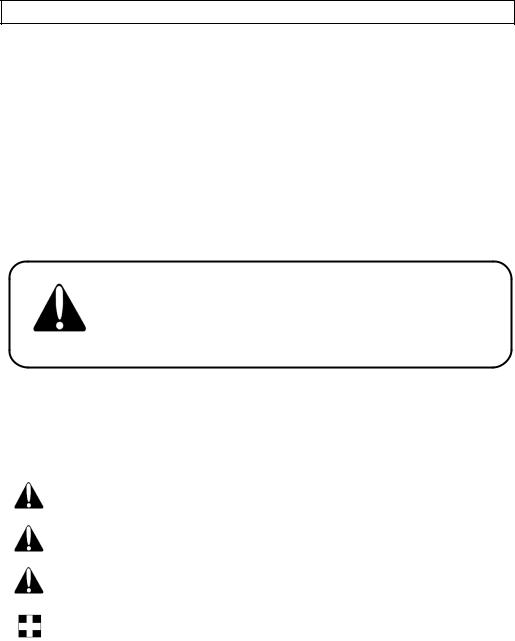
FOREWARD
Thank you very much for purchasing our tractor, which, we feel sure, will give you many years of troubling the service.
The introduction in this manual set out the correct manner of operating, maintaining and checking the tractor to ensure long-term durability.
Please ensure correct operation of the tractor as incorrect operation can cause substantial mechanical damage as well as cause accidents with the associated injuries.
Please note that in some cases differences can exist between this manual and your tractor due to the manufacture’s policy of constant product improvement.
In the event that you strike a problem not covered by this manual please contact your nearest dealer who will assist you in resolving your problem.
|
CALIFORNIA Proposition 65 Warning |
|
The Engine Exhaust from this product contains chemicals known to the |
WARNING |
state of California to cause cancer,birth defects or other reproductive harm |
|
|
|
|
WARNING SIGNS IN THIS MANUAL
The following warning signs in this manual draw additional attention to items of importance for the safe and correct operation of the tractor.
SIGN |
MEANING OF THE SIGN |
|
|
|
|
Danger |
Serious hazard with a very high level of risk of either serious injury or death |
|
|
|
|
Warning |
Hazard or unsafe practice that can lead to severe injury or death. |
|
|
|
|
Caution |
Hazard or unsafe practice that can lead in injury or death. |
|
|
|
|
Important |
Instructions for the correct operation of the machine which, |
|
if followed, will ensure that it performs at it’s best |
||
|
||
|
|
All information,illustrations and specifications in this manual are based on latest information available at the time of publication.The right is reserved to make changes at any time without notice.
7

CONTENTS
Sr. No. |
Description |
Page No. |
|
|
|
1. |
Tractor Identification |
9 |
2. |
About this manual |
10 |
3. |
Introduction & description |
11~12 |
4. |
Owner assistance |
13 |
5. |
ROPS (Roll over protection structures) |
14~16 |
6. |
Safety instructions, Do’s & Don’ts |
17~29 |
7. |
Safety signs |
30~32 |
8. |
Universal symbols |
33 |
|
Section A |
|
9. |
Controls, Instruments & Operations |
34~59 |
|
Section B |
|
10. |
Lubrication & maintenance |
60~79 |
|
Section C |
|
11. |
Specifications |
80~84 |
12. |
Fuel saving Tips |
85~86 |
13. |
Fault tracing |
87~90 |
14. |
Wiring Diagram |
91 |
16. |
Tractor history card |
92 |
17. |
Service record |
93 |
18. |
Daily operating Log |
94 |
19. |
Part replacement record |
95 |
All information, illustrations and specifications in this manual are based on latest information available at the time of publication. The right is reserved to make changes at any time without notice.
8
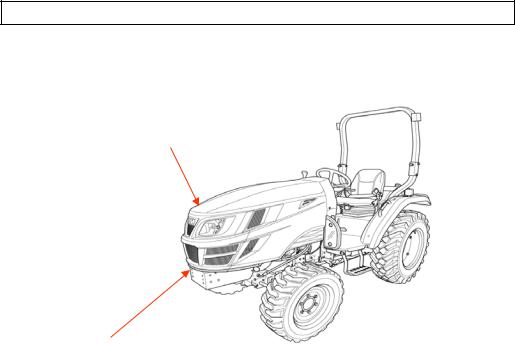
TRACTOR IDENTIFICATION
The engine number is stamped on the left hand side of the engine block.
The chassis number is shown on the left hand side of the tractor as shown in the drawing.
Stamped position of the
Engine type or Number
Stamped position of the chassis number
Illustration A
WARRANTY OF THE PRODUCT.
The manufacturer warrants this product and full details of the warranty are provided on a separate warranty schedule.
SERVICE.
Service is available from any TYM dealer in the country.
PARTS.
To obtain spare parts please contact your nearest dealer and give him the details listed below. Tractor model
Tractor serial number Tractor engine number Part number and description Quantity required.
9

ABOUT THIS MANUAL
This manual has been prepared to assist you in following/adopting the correct procedure for running-in operation and maintenance of your new TYM Tractor.
Your Tractor has been designed and built to give maximum performance, with good fuel economy and ease of operation under a wide variety of operating conditions.
Prior to delivery, The tractor was carefully inspected, both at the factory and by your TYM Dealer/Distributor, to ensure that it reaches you in optimum conditions .
To maintain this condition and ensure trouble free performance.
It is important that the routine services, as specified in this manual, are carried out at the recommended intervals.
Read this Manual carefully and keep it in a convenient place for future reference.
If at any time you require advice concerning your Tractor, do not hesitate to contact your Authorized TYM dealer/Distributor.
He has trained personnel, genuine parts and necessary equipments to undertake all your service requirements.
TYM policy is one of continuous improvement, and the right to change prices, specifications or equipments at any time without notice is reserved.
All data given in this book is subject to production variations.
Dimensions & weight are approximate only and the illustrations do not necessarily show Tractors in standard condition.
For exact information about any particular Tractor, please consult your TYM dealer/Distributor.
10
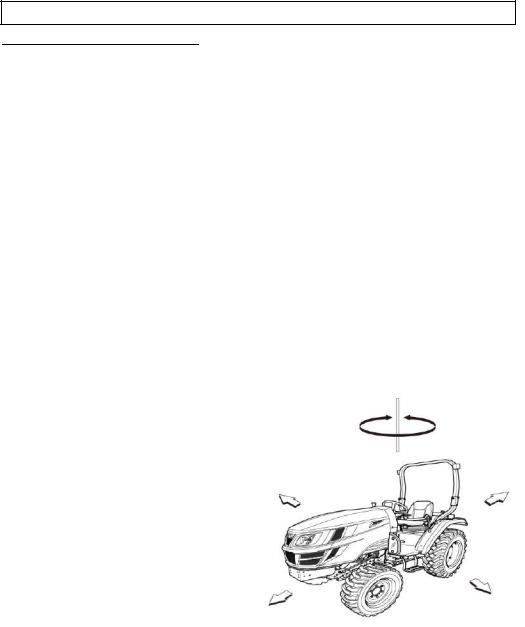
Introduction & Description
► TRACTOR AN INTRODUCTION
The word, ’Tractor’ has been derived from ‘Traction’ which means pulling.
A Tractor is required to pull or haul an equipment, implement or trolley which are coupled to the Tractor body through suitable linkage.
A Tractor can also be used as a prime mover as it has a power outlet source which is also called Power Take or PTO shaft.
In this book the operating, maintenance and storage instructions for all models of TYM Diesel Tractors has been complied.
This material has been prepared in detail to help you in the better understanding of maintenance and efficient operation of the machine.
If you need any information not given in this manual, or require the services of a trained mechanic, please get in touch with the TYM Dealer/Distributor in your locality.
Dealer/Distributors are kept informed of the latest methods of servicing Tractors. They stock genuine spare parts and are backed by the Company’s full support.
Through this manual.
The use of the terms LEFT, RIGHT, FRONT and
REAR must be understood, to avoid any confusion
when following the introductions. |
LEFT TURN |
RIGHT TURN |
|
(COUNTER |
(COUNTER |
||
The LEFT and RIGHT means left and right sides |
|||
|
|
of the Tractor when facing forward in the driver’s seat, Reference to the FRONT indicates the radiator end of the Tractor, while the REAR, indicates the drawbar end (illustration B)
When spare parts are required, always specify the Tractor and engine serial number when ordering these parts. (See illustration A).
This will facilitate faster delivery and help ensure that the correct parts for your particular
Tractor is received.
The tractor serial number is punched on a plate attached to the left hand side of the engine body (illust. A), For easy reference, we suggest you to write the number in the space provided in the owner’s personal data.
CLOCK WISE) |
CLOCK WISE) |
RIGHT |
REAR |
FRONT |
LEFT |
|
illustration A
( Front, Rear,Left,Right Portion)
11
► DESCRIPTION
■ General construction
The transmission case, Clutch, Clutch housing, Engine and Front Axle Support are bolted together to form a rigid unit
■ Front Axle & Wheels
The 4WD front axle is a center-pivot, reverse Eliot type.
The front wheel drive mechanism is incorporated as a part of the axle.
The front wheel drive power is taken off the rear transmission and transmitted to the differential in the front axle where the power is divided into right and left and to the respective final cases.
In the final cases, the transmitted revolution is reduced by the level gears to drive the front wheel. The 4WD mechanism with level gears provides wider steering and greater durability.
■ Engine
The tractors are fitted with vertical, Water-cooled 4-cycle and spherical chamber type YANMAR ENGINES(3TNV88C-KKTF).
■ Clutch and Transmission
A single plate dry clutch (8.86″diameter) is used on these tractors.
Tractor with IPTO(Independent Power Take Off) are fitted with hydraulic Clutch Assy.
The transmission Gear box has Twelve forward speeds & Twelve reverse speeds with high-low selector lever, Presently, TYM Tractors are fitted with partial synchro mesh type gears.
■ Brakes
TYM tractors are provided with independent disc brakes operated by two road travel. A foot brake lever is fitted for parking.
■ Rear axle & Wheels
This is mounted on ball bearings and is enclosed in removable housing which are bolted to the transmission case.
The rim & Disc fitted with Rear tires are bolted to the outer flange of Rear Axle.
■ Hydraulic system & Linkages.
TYM Tractors are fitted with Live (i.e. system is in operation even when clutch is disengaged.) independent, very touch of hydraulic System.
Three point Linkages can be used for category 1 type of implements.
■ Steering
It consists of Hydrostatic Power steering system, which has a hydraulic cylinder and tandem type hydraulic pump
■ Electrical System
A 12 Volt Battery is used to activate the Engine through the Starter Motor and the Electrical system comprising Horn, Head Lamp, Turn signal lamp, Taco-meter, Hour meter, Brake lamp, Gauge lamp, Hazard Lamp.
General or Alternator, Fuse box also from part of the Electrical system.
12

OWNER ASSISTANCE
We at TYM CO.,LTD and your TYM Dealer/Distributor wants you to be completely satisfied with your investment. Normally any problems with your equipment will be handled by your Dealer/Distributor’s Service Departments, however, misunderstanding can occur.
If you feel that your problem has not been handled to your satisfaction, we suggest the following.
Contact the owner or General Manager of the Dealership, explain the problem, and request assistance.
When additional assistance is needed, Your Dealer/Distributor has direct access to your office. If you cannot obtain satisfaction by doing this, contact the TYM CO.,LTD. Office and provide them with;
•Your name, address and telephone number
•Model and Tractor serial number
•Dealer/Distributor Name & Address
•Machine purchase date and Hours used
•Nature of problem
Before contacting TYM CO.,LTD office, be aware that your problem will likely to be resolved in the Dealership using the Dealer’s/Distributor’s facilities, equipment and personnel.
So it is important that your initial contact be with the Dealer/Distributor.
13
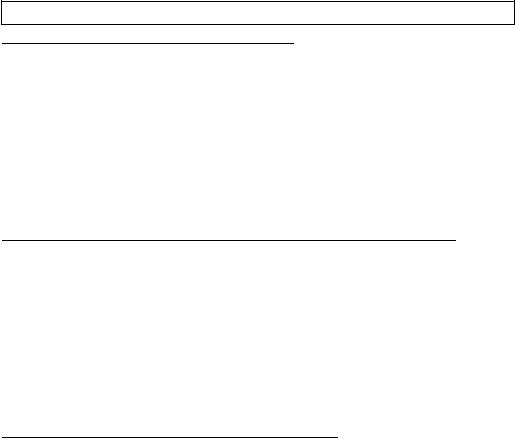
(ROPS) Roll Over Protective Structures
► ROLL OVER PROTECTIVE STRUCTURES (ROPS)
TYM Tractors are equipped with a frame for the protection of operators. In the case of cab tractors the frame is incorporated in the cab structure.
The objective of the frame or cab structure is to protect the operator in the event of a roll over and they are designed to support the entire weight of the tractor in that event.
Each TYM ROPS frame or cab structure is designed and has been tested to meet industry and or Government standards.
Included in these tests were all mounting bases and bolts or other fasteners.
DANGER
For ROPS frames to be effective and protect the operator, the seat belt provided must be worn in order to keep operators within the ROPS protected area in the event of a roll over. Failure to use the seat belt can still cause serious injury or death.
On some models the ROPS frame has a fold down feature, which can be used to enter low buildings etc.
Take care when lowering the upper section of the ROPS frame and take extreme care while driving the tractor with the ROPS frame lowered.
Do not wear the seat belt with the ROPS lowered and please remember that the fold down facility is for special circumstances only and must not be lowered for general use.
Use of the tractor with the ROPS lowered can cause fatal injuries.
As the ROPS frame or cab together with the seat belt was designed to meet certain standards, they must be maintained in good order and condition.
To achieve this objective, both the structure and the seat belt should be inspected on a regular basis (every time the tractor is serviced)
In the event that the seat belt is damaged or frayed, it should be replaced and in the event that the ROPS frame or any part of the mounting structure is damaged or cracked, the faulty component must be replaced with a new unit.
Such a unit must meet all of the test criteria of the original unit.
Fitment of an inferior item or items affects the certification of the entire ROPS structure and the effectiveness of the structure in the event of an accident.
Drilling or welding of the ROPS structure is forbidden.
14
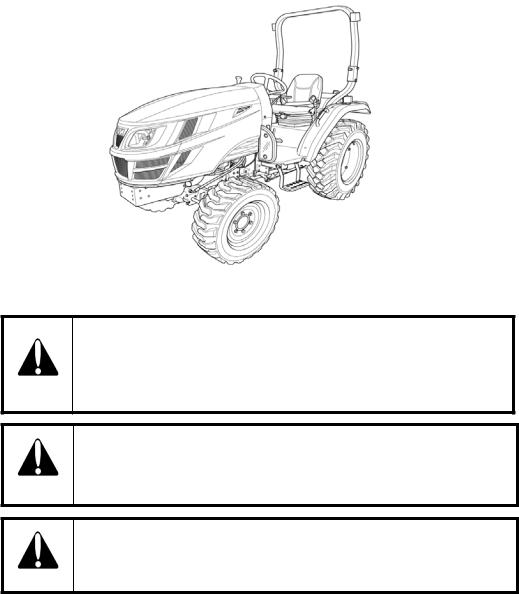
► DAMAGE OF THE ROPS
If the tractor has rolled over or the ROPS has damaged (such as striking an overhead object during transport), It must be replaced to provide the original protection.
After an accident, check for damages to the 1.ROPS.2.Seat 3.seat belt & seat mountings. Before you operate a Tractor, replace all damaged parts.
► DO NOT WELD, DRILL OR STRAIGHTEN THE ROPS
Never attach chains, ropes to the ROPS for pulling purposes; this will cause the Tractor to tip backwards.
Always pull from the Tractor drawbar.
Warning Be careful when driving through door opening or under low overhead objects. Make sure there is sufficient overhead clearance for the ROPS fatal injuries
If the ROPS is removed or replaced, make certain that the proper hardware is used to replace the ROPS and the recommended torque values are applied to
Warning the attaching bolts
Always wear your seat belt if the tractor is equipped with ROPS
Warning
15

How to adjust the Seat
* Damping type
NOTE: Do not use solvents to clean the seat. Use warm water with a little detergent added.
Before operating a Tractor it is important to adjust the seat to the most comfortable position & check whether it is properly locked in its position.
Figure 1 identifies the seat fitted to your Tractor.
► FOR SLIDING SEAT ■ Sliding Seat type
Lift lever (A) and slide the seat to the position you want. Release the lever. Make sure the seat is locked in position.
■ Damping Seat type
Lift lever (A) and slide the seat to the position you want. Release the lever.
Make sure the seat is locked in position. Turn knob (B) to adjust the height of the seat. Turn lever (C) to adjust the damping effect of the seat.
The adjustment required will be dependant on the operator’s weight.
 Check whether the seat properly locked in its position before driving the tractor. Danger
Check whether the seat properly locked in its position before driving the tractor. Danger
|
Always use the seat belt when the ROPS is installed. |
|
Do not use the seat belt if a foldable ROPS is down or there is no ROPS. |
Danger |
Check the seat belt regularly and replace if frayed or damaged |
|
|
16
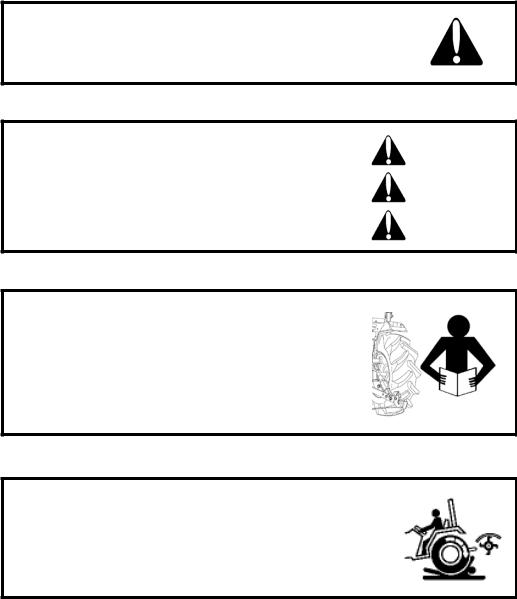
SAFETY INSTRUCTIONS
RECOGNIZE SAFETY INFORMATION
This symbol means ATTENTION! YOUR SAFETY IS INVOLVED.
The message that follows the symbol contains important information about safety. Carefully read the message
SIGNAL WORDS.
A signal word―DANGER, WARNING OR CAUTION―is used with safety alert symbol. DANGER identifies the most serious hazards. Safety signs with signal Word ―DANGER OR WARNING―are typically near specific hazards. General precautions are listed on CAUTION safety signs.
DANGER
WARNING
CAUTION
READ SAFETY INSTRUCTION
Carefully read all safety instructions given in this manual for your safety. Tempering with any of the safety devices can cause serious injuries or death. Keep all safety signs in good condition. Replace missing or damaged safety signs.
Keep your tractor in proper condition and do not allow any unauthorized modifications to be carried out on the Tractor, which may impair the function/safety and affect Tractor life.
PROTECTION CHILDREN
Keep children and others away from the Tractor while operating. BEFORE YOU REVERSE
-Look behind Tractor for children.
-Do not let children to ride on Tractor or any implement.
17
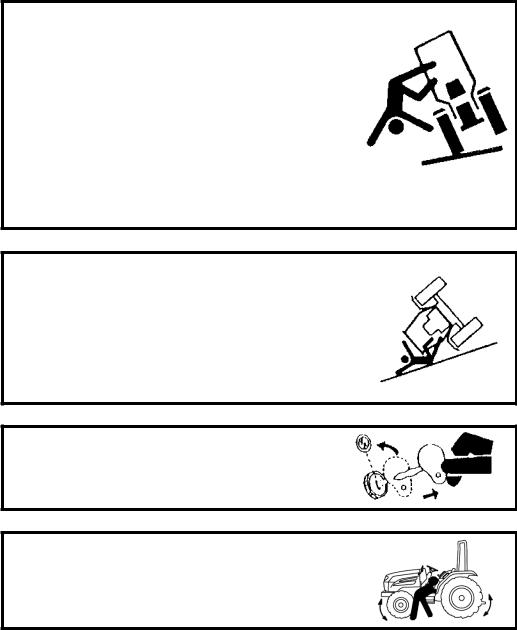
USE OF ROPS AND SEAT BELT
The Roll Over Protective Structure(ROPS) has been certified to industry and/or government standards. Any damage or alternation to the ROPS, mounting hard-ware, or seat belt voids the certification and will reduce or eliminate protection for the operator in the event of a roll-over. The ROPS, mounting hardware, and seat belt should be checked after the first 100 hours of Tractor and every 500 hours thereafter for any evidence of damage, wear or cracks. In the event of damage or alteration, the ROPS must be replaced prior to further operation of the Tractor.
The seat belt must be worn during machine operation when the machine is equipped with a certified ROPS.
Failure to do so will reduce or eliminate protection for the operator in the event of a roll over.
PRECAUTION TO AVOID TIPPING
Do not drive where the Tractor could slip or tip.
Stay alert for holes and rocks in the terrain, and other hidden hazards.
Slow down before you make a sharp turn.
Driving forward out of a ditch or mired condition could cause Tractor to tip over backward. Back out of these situations if possible
PARK TRACTOR SAFELY
Before working on the Tractor ;
Lower all equipment to the ground.
Stop the engine and remove the key
KEEP RIDERS OFF TRACTOR
Do not allow riders on the Tractor.
Riders on Tractor are subject to injury such as being stuck by foreign objects and being thrown off of the Tractor
18
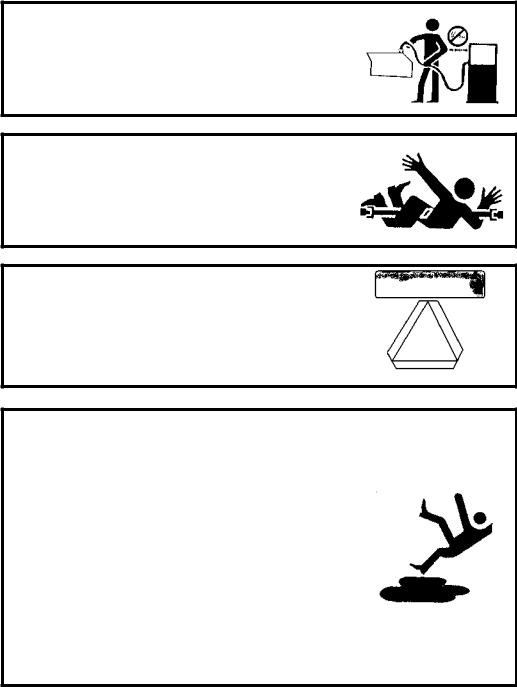
HANDLE FUEL SAFELY-AVOID FIRES
Handle fuel with care; it is highly flammable. Do not refuel the Tractor while smoking or near open flame or sparks.
Always stop engine before refueling Tractors.
Always keep your tractor clean of accumulated grease, and debris. Always clean up spilled fuel.
STAY CLEAR OF ROTATING SHAFTS
Entanglement in rotating shaft can cause serious injury or death. Keep PTO shield in place at all times.
Wear close fitting clothing. Stop the engine and be sure PTO drive is stopped before making adjustments, connections, or cleaning out PTO driven equipment.
ALWAYS USE SAFETY LIGHTS AND DEVICES
Use of hazard warning lights and turn signals are recommended when towing equipment on public roads unless prohibited by state or local regulations.
Use slow moving vehicle (SMV) sign when driving on public road during both day & night time, unless prohibited by law
PRACTICE SAFE MAINTENANCE
Understand service procedure before doing work. Keep the surrounding area of the Tractor clean and dry. Do not attempt to service Tractor when it is in motion. Keep body and clothing away from rotating shafts.
Always lower equipment to the ground. Stop the engine. Remove the key. Allow Tractor to cool before any work repair is caused on it.
Securely support any Tractor elements that must be raised for service work.
Keep all parts in good condition and properly installed. Replace worn or broken parts. Replace damage/missing decals. Remove any buildup of grease or oil from the Tractor.
Disconnect battery ground cable(−) before making adjustments on electrical systems or welding on Tractor
19
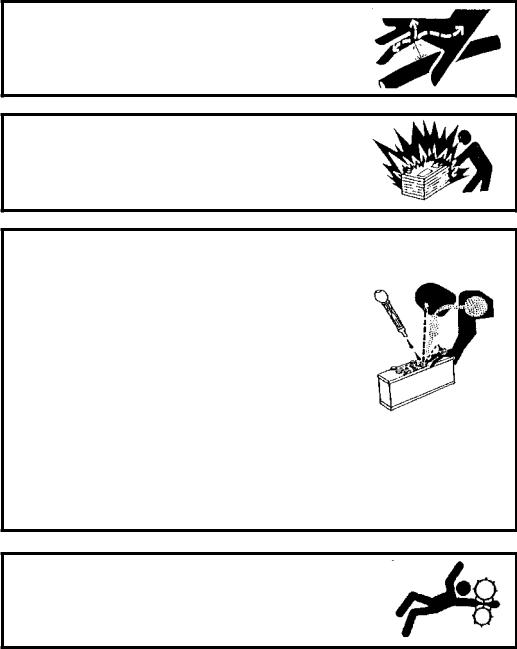
AVOID HIGH-PRESSURE FLUIDS
Escaping fluid under pressure can penetrate the skin causing serious injury. Keep hands and body away from pinholes and nozzles, which eject fluids under high pressure. If ANY fluid is injected into the skin. Consult your doctor immediately.
PREVENT BATTERY EXPLOSIONS
Keep sparks, lighted matches, and open flame away from the top of battery. Battery gas can explode.
Never check battery charge by placing a metal object across the poles.
PREVENT ACID BURNS
Sulfuric acid in battery electrolyte is poisonous. It is strong enough to burn skin, cause holes in clothing and cause blindness if found entry into eyes.
For adequate safety always;
1.Fill batteries in a well-ventilated area.
2.Wear eye protection and acid proof hand gloves
3.Avoid breathing direct fumes when electrolyte is added.
4.Do not add water to electrolyte as it may splash off causing severe burns.
If you spill acid on yourself; 1.Flush your skin with water.
2.Flush your eyes with water for 10-15 minutes. Get medical attention immediately.
SERVICE TRACTOR SAFELY
Do not wear a necktie, scarf or loose clothing when you work near moving parts. If these items were to get caught, severe injury could result.
Remove rings and other jeweler to prevent electrical shorts and entanglement in moving parts.
20
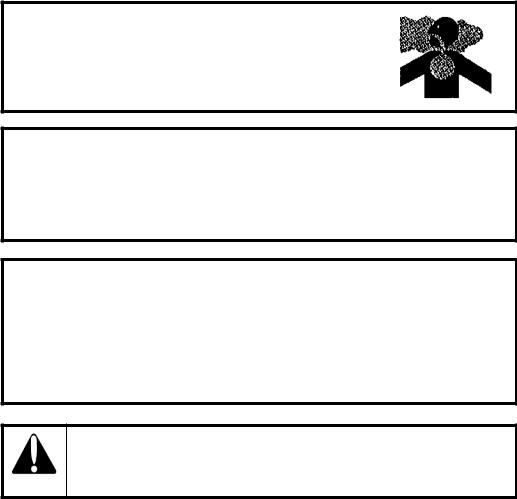
WORK IN VENTILATED AREA
Do not start the Tractor in an enclosed building unless the doors & windows are open for proper ventilation, as tractor fumes can cause sickness or death. If it is necessary to run an engine in an enclosed area remove the exhaust fumes by connecting exhaust pipe extension.
TRACTOR RUNAWAY
1.The tractor can start even if the transmission is engaged position causing Tractor to runaway and serious injury to the people standing nearby the tractor.
2.For additional safety keep the pull to stop knob (fuel shut off control) in fully pulled out position. Transmission in neutral position, Foot brake engaged and PTO lever in disengaged position while attending to Safety Starter Switch or any other work on Tractor.
SAFETY STARTER SWITCH
1.Clutch operated safety switch is provided on all Tractors which allow the starting system to become operational only when the Clutch pedal is fully pressed.
2.Do not By-pass this safety starter switch or work on it. Only Authorized Dealers are recommended to work on safety starter switch.
3.On some models Safety Starter switch is provided on transmission High-low shifter lever and in PTO shifter lever.The tractor can be started only if High-low shifter lever is in neutral position.
Safety Starter Switch is to be replaced after every 2000 hours/4 years,
whichever is earlier
Caution
21

SAFE OPERATION OF YOUR TRACTOR
The manufacturer of your tractor has made every effort to make it as safe as is humanly possible.
Beyond this point it is the responsibility of the operator to avoid accidents and we ask that you read and implement our suggestions for your safety.
Ensure that only trained and competent operators use this tractor and ensure that they are fully conversant with the machine and aware of all it’s control and safety features.
Operators should not operate the tractor or associated machinery while tired or untrained.
To avoid accidents please ensure that the operator wears clothing which will not get entangled in the moving parts of the tractor or machine and protect him or her from the elements.
When spraying or using chemicals, please ensure that clothing and protective equipment is worn which prevents respiratory or skin problems.
For full details consult the manufacturer of the chemicals.
To avoid lengthy exposure to noise ensure that ear protection is worn.
If adjustment to the tractor or machinery need to be made ensure the tractor or machine are turned off beforehand.
Use of certified Roll Over Protection Structure (ROPS) is a must while operating a tractor. Use of seat belt is a must while operating a tractor.
In summary, ensure at all times that the safety of the operator and any other worker is paramount.
22
SAFETY TIPS DURING MAINTENANCE
1. At least on a daily basis check all oil levels.
Water level in the radiator and electrolyte level in the battery and perform services according to the service schedule.
2.Ensure tire pressure are even and the correct pressure for the job being done is maintained.
3.Check to ensure that the all controls and preventative mechanisms of the Tractor and implement work correctly and effectively.
4.Ensure that an adequate set of the correct tools is available for maintenance and minor repairs.
5.Ensure that all service work and repairs are carried out on a flat area with a concrete or similar floor.
Do not carry out service work on a tractor until it is switched off, and the parking brake applied and wheels choked.
Where a tractor is started in a confined area, ensure that the area is well ventilated as exhaust gases are very harmful, and can cause death.
6.Do not work under raised implements.
7.When changing wheels or tires ensure that a suitable wheel stand is placed under the axle prior to removing the wheel and the wheels are chocked.
8.Where guards or shields need to be removed to perform a service or repair, ensure that the guard or shield is correctly reinstalled before starting the Tractor.
9.Never refuel near an open flame or with an overheated engine. Ensure to turn off Engine before refueling.
10.The cooling system operates under pressure, take care when removing the Radiator cap on a hot engine to prevent being scalded by steam or hot water.
Do not add water in the radiator when the engine is hot.
Add water to the radiator only after the engine cools down completely.
11.To prevent fires keep the tractor including the engine clean and free from inflammable material and well away from fuels and other inflammable material.
23
► MOUNTING AND DEMOUNTING IMPLEMENTS
(1) Ensure that all mounting and removal of implements is done on safe flat ground.
Ensure no one is between the Tractor and implement and do not get under the implement to avoid accidental injuries.
(2)After mounting the implement, ensure that all sway chains are correctly adjusted and, where PTO shafts are used that the shaft is fitted and secured correctly.
(3)Where heavy implements are used, ensure that the combination is well balanced or use proper ballast to achieve balance.
(4)Before leaving the tractor at any time, lower the implement, stop the PTO shaft where applicable, set the parking brake and switch off the engine.
(5)While operating the implements with the PTO keep all bystanders away from any moving parts and do not attempt to make adjustments while the machine is running.
(6)Only the driver should ride on the Tractor with the ROPS frame fitted and with the seat belt properly fastened.
(7)Where young children are present, particular care should be taken and the tractor should not be moved until the whereabouts of all children is known.
(8)Only trained operators should operate the Tractor and so taking care to ensure that other workers are not injured.
In particular they should take care during dusty operations, which wil reduce visibility substantially.
(9)Never start the tractor unless the transmission is out of gear, the operator is in the seat and all round safety has been checked.
(10)Only operate the tractor seated in the drivers seat and never turn or brake suddenly at high
speed as this can cause a roll-over and serious injury or death.
(11)When traveling on a public road ensure that the tractor and driver both meet all laws relating to safety and licensing.
When traveling with wide implements use red flags on the extremities and observe all legal including escort requirements.
(12)When operating under adverse conditions, hilly terrain or on bad ground adjust the speed of the tractor to suit the conditions, safety comes first.
Never drive down hill at high speed or with the transmission in neutral. Use of the braking capacity of the engine as well as the service brakes.
Do not try to change gear going up or down a steep slope, select the correct gear before starting.
(13)Take care when traveling uphill with a heavy implement to ensure that it does not overbalance
and tip up the front end.
(14)Never remove or modify the seat belt.
(15)Never remove, modify or repair the ROPS frame.
PLEASE REMEMBER THAT A LITTLE BIT OF EXTRA CARE CAN PREVENT SERIOUS INJURY OR TEATH AND AVOID DAMAGE TO YOUR TRACTOR.
24
► THE FOLLOWING PRECAUTIONS ARE SUGGESTED TO HELP PREVENT ACCIDENTS.
A careful operator is the best operator.
Most accidents can be avoided by observing certain precautions .
Read and take the following precautions before operating the Tractor to prevent accidents. Tractor should be operated only by those who are responsible and properly trained to do so.
■ The Tractor
1.Read the operator’s manual carefully before using the tractor. Lack of operating knowledge can lead to accidents.
2.Use an approved rollover bar and seat belt for safe operation.
Overturning of a tractor without a rollover bar can result in death or injury.
3.Do not remove ROPS (Roll Over Protective Structure).
Always use the seat belt.
4.Fiberglass canopy does not give any protection.
5.To prevent falls, keep steps and platform clear of mud and oil.
6.Do not permit anyone but the operator to ride on the Tractor. There is no safety place for extra riders.
7.Replace all missing, illegible or damaged safety signs.
8.Keep safety signs clean of dirt and grease
■ Servicing the Tractor
1.Keep the tractor in good operating condition for your safety. An improperly maintained Tractor can be hazardous.
2.Stop the engine before performing any service on the tractor.
3.The cooling system operates under pressure, which is controlled by the radiator cap. It is dangerous to remove the cap while the system is hot.
First turn the cap slowly to stop and allow the pressure to escape before removing the cap entirely.
4.Do not smoke while the refueling the tractor. Keep away any type of open flame.
5.The fuel in the injection system is under high pressure and can penetrate the skin.
Unqualified persons should not remove or attempt to adjust a pump, injector, nozzle or any part of the fuel injection system.
Failure to follow these instructions can result in serious injury.
6.Keep open flame away from battery or cold weather starting aids to prevent fire or explosions.
7.Do not modify or alter or permit anyone else to modify or alter this tractor or any of its components or any tractor functions
25
■Operating the tractor
1.Before starting the tractor apply the parking brake, place the PTO (Power Take Off) lever in the “OFF” position, the hydraulic control levers in the downward position, the remote control valve levers in the neutral position( if fitted) and the transmission in neutral.
2.Do not start the engine or controls while standing besides the tractor. Always sit on the tractor seat when the engine or operating controls.
3.Safety starter switch.
In order to prevent the accidental starting of the tractor, a safety switch has been provided.
The starting system of the tractor is connected through this switch, which becomes operative only when the clutch pedal is depressed.
On some models shuttle shifter lever and PTO button should also be in neutral position for completing the starting circuit.
Do not bypass the safety starter switch.
Consult your TYM Tractor Dealer/Distributor if safetystarting switch malfunctions.
4.Avoid accidental contact with the gear shifter lever while the engine is running. Unexpected Tractor movement can result from such contact.
5.Do not get off or climb the tractor while it is in motion.
6.Shut off the engine, remove the key and apply the parking brake before getting off the tractor.
7.Do not operate the tractor in an enclosed building without adequate ventilation. Exhaust fumes can cause death.
8.Do not park the tractor on a steep slope.
9.If power steering or Engine seizes to operate, stop the tractor immediately.
10.Pull only from the swinging draw bar or the lower link drawbar in the down position.
Use only a drawbar pin that locks in place.
Pulling from the tractor rear axle carriers or any point above the rear axle may cause the Tractor’s front end to lift.
11. If the front end of the tractor tends to rise when heavy implements are attached to the three-point linkage, install front end or front wheel weights.
Do not operate the tractor with a light front end.
12.Always use hydraulic position control lever when attaching equipments/implement and when transporting equipment.
Be sure that the hydraulic couplers are properly mounted and will disconnect safely in case of accidental detachment of implement.
13.Do not leave equipment/implement in the raised position.
14.Use the flasher/ Turn signal lights and Slow Moving Vehicle (SMV) signs when driving on public roads during both day and night time, unless prohibited by law.
15.Dim tractor lights when meeting a vehicle at night.
Be sure the lights are adjusted to prevent the blinding on the eyes of coming vehicle operator.
16.Emergency stopping instruction; If tractor fails to stop even after application of brakes, Pull the knob of fuel shut off control rod.
26
■Driving the tractor
1.Watch where you are going especially at row ends, on roads, around trees and low hanging obstacles.
2.To avoid upsets, drive the tractor with care and at speeds compatible with safety, especially when operating over rough ground, crossing ditches or slopes, and when turning at corners.
3.Lock the tractor brake pedals together when transporting on roads to provide proper wheel braking.
4.Keep the tractor in the same gear when going downhill as used when going uphill. Do not coast
or free wheel down hills.
5.Any towed vehicle and/or trailer whose total weight exceeds that of the towing Tractor, must be equipped with its own brakes for safe operation.
6.When the tractor is stuck or tires are frozen to the ground, back out to prevent upset.
7.Always check overhead clearance, especially when transporting the tractor.
■Operating the PTO (Power Take Off)
1.When operating PTO driven equipment, shut off the engine and wait until the PTO stops before getting off the tractor and disconnecting the equipment.
2.Do not wear loose clothing when operating the power take-off or near rotating equipment.
3.When operating stationery PTO driven equipment, always apply the tractor parking brake and block the rear wheels from front and rear side.
4.To avoid injury, always move down flip part of PTO. Do not clean, adjust or service PTO driven equipment when the tractor engine is running.
5.Make sure the PTO master shield is installed at all times and always replace the PTO shield cap When the PTO is not in use.
■Diesel fuel
1.Keep the equipment clean and properly maintained.
2.Under no circumstances should gasoline, alcohol or blended fuels be added to diesel fire or explosive hazard. Such blends are more explosive than pure gasoline. In a closed container, such as a fuel tank. DO NOT USE THESE BLENDS.
3.Never remove the fuel cap or refuel the tractor with the engine running.
4.Do not smoke while refueling or when standing near fuel.
5.Maintain control of the fuel filler pipe when filling the tank.
6.Do not fill the fuel tank to capacity. Allow room for expansion.
7.Wipe up spilled fuel immediately. 8.Always tighten the fuel cap securely.
9.If the original fuel tank cap is lost, replace it with genuine cap. A none approved cap may not be safe. 10.Do not drive equipment near open fire.
11.Never use fuel for cleaning purpose.
12.Arrange fuel purchases so that winter grade fuel are not held over and used in the spring.
N.B: It is suggested that after repairs if any of the Safety Decal/sign is peeled/defaced, the same may be replaced immediately in interest of your safety.
27

DO’S AND DON’T’S
► DO’S-For Better performance
DO-Ensure that safety shields are in place and in good condition. DO-Read all operating instructions before commencing to operate Tractor. DO-Carry out all maintenance tasks without fail.
DO-Keep the air cleaner clean.
DO -Ensure that the correct grade of lubricating oils is used and that they are replenished and changed at the recommended intervals.
DO-Fit new sealing rings when the filter elements are changed.
DO-Watch the oil pressure gauge or warning light and investigate any abnormality immediately. DO-Keep the radiator filled with clean water and in cold weather use anti-freeze mixture. Drain
the system only in an emergency and fill before starting the engine. DO-Ensure that the transmission is in neutral before starting the engine. DO-Keep all fuel in clean storage and use a filter when filling the tank.
DO-Attend to minor adjustments and repairs as soon as necessity is apparent.
DO-Allow the engine to cool before removing the radiator filler cap and adding water, remove the radiator cap slowly.
DO-Shift into low gear when driving down steeps hills. DO-Latch the brake pedals together when driving on a highway. DO-Keep draft control lever fully down when not in use.
Don’ts-For safe operation
DON’T-Run the engine with the air cleaner disconnected.
DON’T-Start the tractor in an enclosed building unless the doors and windows are open for proper ventilation.
DON’T-Operate the tractor or engine while lubricating or cleaning.
DON’T-Allow the tractor to run out of diesel fuel otherwise it will be necessary to vent the system. DON’T-Temper the fuel injection pump, If seal is broken the warranty becomes void. DON’T-Allow the engine to run idle for a long period.
DON’T-Run the engine if it is not firing on all cylinders.
DON’T-Ride the brake or clutch pedal. This will result in excessive wear of the brake lining, clutch driven member and clutch release bearing.
28
